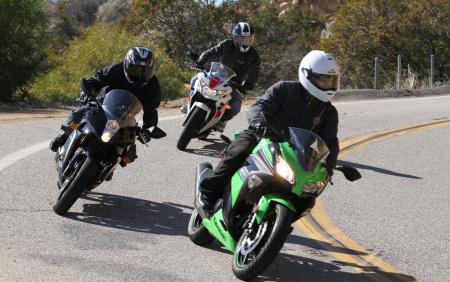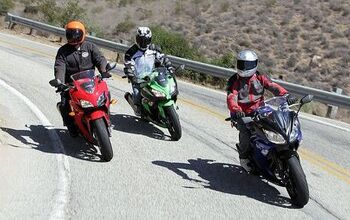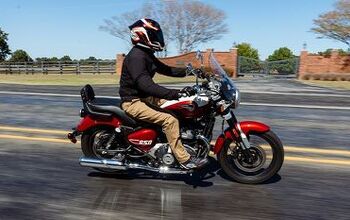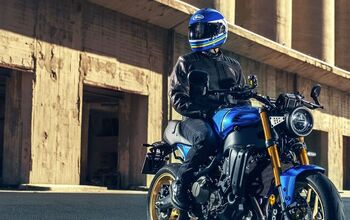2013 Beginner Sportbike Shootout - Video - Motorcycle.com
The 250cc sportbike market in America is reaching a high point. Blame the sluggish economy or rising gas prices, but quarter-liter streetbikes are becoming a hot commodity. Around town, they’re capable, gas-sipping commuters. In the twisties, they’re fun to wind out and throw around. And on your wallet, a 250-class motorcycle can mean the difference between riding and driving. And if you’re reading this, you know none of us wants that.
To that end, we revved up three of these bikes for evaluation. Two are the best-known in the class (one is all-new for 2013) and the third is a lesser known bargain brand, thrown to the wolves to see how it stacks up against the class leaders.
The Lineup
For years, Kawasaki ruled the quarter-liter streetbike world with its sporty Ninja 250 – mainly because of a dearth of competition. In 2011, however, Honda shook up the class when it released the CBR250R with electronic fuel injection (EFI) and available anti-lock brakes (ABS). Kawi’s hold on the 250 market became suddenly and noticeably tenuous. With women riders budding, gas prices on the rise and motorcycle manufacturers across the board desperate to attract new riders, it was clear that Kawasaki’s outdated, outmoded and carb-fed Ninjette was due for (at least) a makeover.
Kawi did far more than that when it completely blew up the class in 2013 with the Ninja 300. As our Troy Siahaan noted in his review, the 300’s larger displacement comes mainly from a longer stroke. Troy went into full technical detail in his piece, so there’s no need to revisit all the specs here when you can just click the link above.
But suffice to say that, with the addition of EFI (eliminating EPA-mandated, super-lean carb settings) and the optional ABS, it was clear the new Ninjette was gunning to reclaim its perch atop the entry-level peak.
So, despite the difference in displacement, the single-barrel CBR250R and the parallel-Twin Ninja 300 are obvious competitors. While we expected to see the Ninja outperform its smaller counterpart in performance metrics, we were curious with how these bikes sized up in other areas: handling, ease of use, rider comfort, instrumentation, et al.
Would the extra displacement put the sporty Ninja head and shoulders above the Honda? Or could the CBR’s more standard set-up negate the Kawasaki’s obvious performance advantage?
Check out the Honda CBR250 Forum.
Another factor we wanted to consider was value. Consumers are voting with their pocketbooks, as the CBR250R and Ninja 250 were the best-selling streetbikes for their respective manufacturers last year. But with MSRPs in this class inching their way upward, some beginners might instead be attracted to a scooter or used car.
The outlier in this trio is the less-well-known Hyosung (by the way, it’s pronounced “YO-sung”) GT250R. Our man Tom Roderick recently reviewed the mighty Yo on its own merits. But if you’re interested to see how a cut-rate, bargain-brand bike compares to models from the big boys, we’ve got a comparo for you.
Tale of the Tape
According to the manufacturer’s own spec sheet, the GT250R’s wheelbase, seat height and overall length are exactly the same as its big brother, the GT650R – making it evident this is less a beginner bike than just a smaller-displacement V-Twin engine bolted into the chassis of a much larger motorcycle. Naturally, this bulk affects its performance.
“The Hyosung feels 10% bigger than the other bikes,” notes Editor-in-Chief Kevin Duke, “and the long stretch to the bars is nigh on ridiculous for a bike with this kind of power – it’s the most radical seating position of the trio.”
The handlebar demands the Hyosung’s rider to crouch over the (also 650-sized) fuel tank in a sporty riding position. Compared to the more upright, rider-friendly position the Ninja and CBR share, this incongruous posture – belly scraping the tank, chin over the filler cap – borders on the absurd. The rider is positioned for an acceleration rush that never materializes.
“The racy seating position of the Hyosung is aggressive but uncomfortable,” Content Editor Tom Roderick noted. “It might be great for canyon or track riding but otherwise it’s a slow-torture device. The combination of the clip-ons below the triple clamp and the high seat puts pressure on your wrists and on the inner bend of your elbows.”
Meanwhile, both Japanese bikes perch the rider in a more natural, vertical posture than the Hyosung. The Kawi’s rider’s knees feel slightly more bent that the CBR rider’s, but it’s not at all uncomfortable; it just lends to the Ninja’s sportier profile. It’s fair to say all three provide decent wind protection up high and fine heat deflection down low.
| By the Numbers | |||
| Model | Seat Height | Curb Weight | Wheelbase |
| Honda CBR250R | 30.5 in. | 357 lbs | 53.9 in. |
| Hyosung GT250R | 32.7 in. | 416 lbs | 56.5 in. |
| Kawasaki Ninja 300 | 30.9 in. | 379 lbs | 55.3 in. |
Because the Ninja 300 and CBR250R feature purpose-built chassis, both are smaller and lighter than the next-larger bikes in their respective lines. As expected, the 300 is slightly longer and heavier than Honda’s 250, but its seat height is less than half an inch higher, so both bikes should capably accommodate women, shorter riders and newbies. The GT’s 32.7-inch seat height will annoy shorter riders.
Building steppingstone bikes is Branding 101, folks. By designing fun and dependable entry-level motorcycles that are ladders up the chain to larger models, OEMs strive to build brand loyalty. Any entry-level rider who outgrows the small-displacement class on display here should be more than ready to step up to a Ninja 650 or CBR500R without trepidation. In the case of the Hyosung, though, the next level up is nothing more than the same motorcycle with a bigger engine.
But in keeping with the theme of this comparo, the old adage “You get what you pay for” applies, right? Well, more on that later.
More by Jon Langston



































Comments
Join the conversation